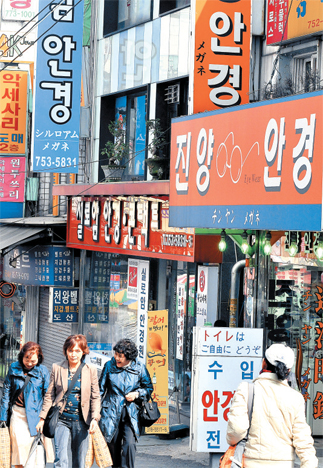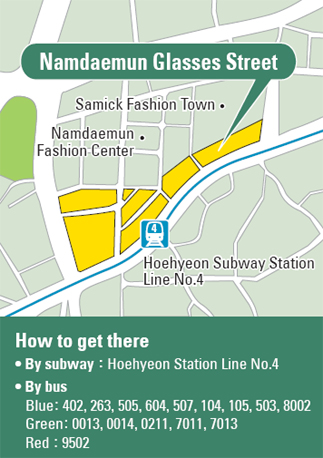Weaker won creates glasses spectacle

A customer tries on a pair of spectacles at an optician’s in Namdaemun’s “Glasses Street” in central Seoul. By Jeon Min-gyu
The salesman drops in promises of hot coffee as an added incentive.
After a brief conference, the tourists follow the assistant into the shop, keen on the hot coffee offer and the sales pitch:
“Cheap!” and “Good service,” cry out the vendors in Japanese.
The history of the eyeglass market in Namdaemun dates back to the early 1980s.
“The grand children of some customers from earlier years still visit the store,” said 74-year-old Goh Jong-hwa, owner of Seo Dok Optical-Contact Lens on the second floor of a building on the street.
Goh is one of the old guard who still retails spectacles, ranging from high-end Gucci, Ray Ban and Zeissproducts to lower-end Chinese and Korean glasses.
He’s been running his shop since March 1980. Before that, he operated a small retail shop in Myeongdong for nearly 20 years.
Today, the glasses shops spread from the far end of the Namdaemun complex to neighboring Myeongdong.
Goh said he relocated to Namdaemun because he was entering the wholesale business after importing foreign glasses.
“Back then, there was no plastic and all of the lenses were made of glass,” Goh said. “I imported compressed lenses and distributed to other shops.”
Even today the wholesale factor is the difference between the Namdaemun and the Myeongdong markets. Many of the opticians in Namdaemun sell retail and wholesale, while the ones in Myeongdong are only retailers.
Park Chung-ryeul is what you might call a loyal customer. He flew all the way from the United States to get several pairs of eyeglasses for himself and his wife and two kids, Alex and Kevin.
“Alex is more focused on fashion and Kevin doesn’t really care,” Park said.
His father was one of Seo Dok’s regulars for many years. He would visit the shop even after the family relocated to the States.

Namdaemun store signs sport come-ons in Japanese since there are so many tourists taking advantage of the weak won-yen exchange rate. By Jeon Min-gyu
“In the 80s there were just a handful of stores,” Goh said. “Today it’s hard to track them all.”
You Hwang-go, owner of Dokebi, a glasses shop in Namdaemun and chairman of the Korean Optometric Association, says one of the strength of shops in Namdaemun is the one-stop service.
“You can get your eyes checked here and the opticians in the store provide you with an appropriate pair of glasses,” You said.
Although a customized frame is not available, the lens could be resized to fit a certain frame.
You said he used to work for his brother who owned a glasses shop in Namdaemun. He went independent and opened his own shop in 1981.
Another strength of the Namdaemun glasses shops is customers have a huge range to choose from.
“In the past, 90 percent of the glasses distributed throughout the country came from Namdaemun, which then was mostly wholesale,” You said. “Even today I would say 70 percent is distributed from Namdaemun.”
Because the industry closely follows rapidly changing fashions, you can usually find the latest style in Namdaemun.
“In the past, a vogue would last at least two years,” You said. “Today the trend switches every two to three months.”
Although it’s not easy to keep up with the latest trend, the Namdaemun market tries to adapt.
Another reason for the cluster of glasses shops at this central locale in the capital is the price.

“Foreigners or Korean students who are studying abroad purchase two or three pairs of glasses when they visit the market,” You said.
Kim Young-do, who owns the Segero store, said glasses here are about 40 percent cheaper than at other places.
You said that many shops converted from wholesale to retails 15 years ago, which contributed to the sharp drop in sales here.
He said the price of eyeglasses will probably drop further especially since 15,000 opticians graduate from 45 schools every year, causing a glut.
You said since many of the foreign customers are Japanese, stores hire sales reps who are fluent in Japanese. He added that service in English is available as well.
Chinese is still not spoken fluently in these parts.
In the past few weeks, the number of consumers from Japan seeking high-end goods seems to have surged, although there are no hard numbers available.
“Since Korea’s currency is weaker than the yen at the moment, Japanese customers are flocking to Namdaemun to buy glasses,” said Goh of the Seo Dok store.
Kim of Segero said the market accepts U.S. dollars and yen but does not appear to accept European currency.
“Today the most popular design has sharp corners,” said Goh, adding that wine colored specs are particularly popular these days.
“The sharper image and sophisticated colors make a person look younger and more vibrant, while a round shaped frame provides a relaxing appearance.
“It seems that with the negative economic situation people want to look more aggressive than laid back.”
By Lee Ho-jeong [ojlee82@joongang.co.kr]










with the Korea JoongAng Daily
To write comments, please log in to one of the accounts.
Standards Board Policy (0/250자)